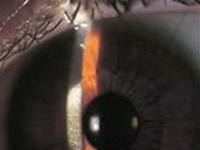Cogan Syndrome
Cogan syndrome is keratitis syndrome associated with cochlear implant disease, progressive progression and hearing loss after two years. In fact there are atypical cases when there are other lesions or disease progression that lasts more than two years.
 Eye manifestations in Cogan syndrome (Photo: TTO) Common Cogan syndrome in young people, more than 30% of cases are in the context of systemic disease. Commonly coordinated organs are: cardiovascular, kidney, joint, nerve, digestive, skin and mucosa. Tests for detection include inflammatory syndrome, immune system abnormalities.
Eye manifestations in Cogan syndrome (Photo: TTO) Common Cogan syndrome in young people, more than 30% of cases are in the context of systemic disease. Commonly coordinated organs are: cardiovascular, kidney, joint, nerve, digestive, skin and mucosa. Tests for detection include inflammatory syndrome, immune system abnormalities.
So far, the pathological mechanism has not been accurately determined. The disease is common in young people aged 20-40 years. The prevalence is nearly the same for men and women: about 52% for males and 48% for females. HLA factor analyzes show that people with HLA A9, BW35, CW4. Cogan's disease may be a partial manifestation of systemic diseases such as rheumatism, Basedow's disease, Crohn's disease.
Today researchers show a close association between this syndrome and inflammatory disease around the arteries. In addition, scientists also mentioned the role of Chlamydia trachomatis, a sexually transmitted disease, because more than 50% of people exhibit Cogan's syndrome with a positive serologic reaction to Chlamydia.
Common expressions
- Eye damage: seen in 42% of cases, often both eyes. Manifestations of eye pain (50%), red eyes (74%), photophobia (50%), lacrimation (50%), vision loss (42%). On eye examination see the nodular inflammation infection at the back of the cornea. In addition, there are other lesions such as keratitis, uveitis and periorbital inflammation. Severe manifestations are more rare than corneal ulcers, corneal perforation. Normally, patients with reduced vision are few and slow, but there are many severe cases, patients may be blind after a very short time.
- Signs of vestibular cochlea: The disease usually begins with vestibular syndrome and profound deafness. Signs suggest that the patient feels tinnitus, symptoms disappear and reappear with a more severe degree. In addition, patients also experience nausea, nystagmus, imbalance.
Symptoms occur for several days and then disappear. However, after relapse after the disease progresses, the hearing ability decreases. Most cases result in complete deafness after 2-3 years. When a normal X-ray is taken, it is easy to miss damage because there is no expression, but CT or MRI can show calcification, blockage of the half-mast, vestibular, cochlear implant.
- Body signs: Fever: 39% of cases. Weight loss: 26% of cases. Patients are often tired of eating, walking is difficult. There are patients who lose more than 10kg in a short time.
- Symptoms in other organs: Cardiovascular system: aortic valve opening, mitral mitral valve, myocarditis. Vascular manifestations include thickening of the artery, limb loss, embolism abdominal pain, reversible pain, Raynauld syndrome. When angiogram shows blood clots, diffuse thrombosis, aneurysms. Depending on the blood vessel damage, organs such as kidney, brain, heart have symptoms such as kidney failure, hypertension, cerebral vascular accident, myocardial infarction .
Signs of osteoarthritis include arthritis, joint swelling, joint deformity, osteoarthritis, muscle pain, muscle atrophy. The skin and mucous membranes of patients are often dry, atrophic, ulcerative, sometimes pruritic, rash. Reflexes of reduced muscles, skin numbness, chronic dermatitis. Signs of gastrointestinal system include liquid diarrhea, bloody stools, prolonged abdominal pain.
Many cases of palpable liver and spleen. In the lungs manifested by interstitial pneumonia. The patient has a dry or bloody cough. In the exacerbation of patients with mild dyspnea, pleurisy, pleural effusion. Sometimes patients have endocrine signs such as obesity, hyperthyroidism, hypothyroidism, testicular atrophy .
Diagnosis: Tests have limited results, can only be detected during exacerbations. Increased white blood cells, increased platelets, decreased red blood cells, coagulopathy. Clear inflammatory reactions: increased sedimentation, increased fibrinogen, increased gamma and alpha2 globulin. Liver function is usually within normal limits. Analysis of urine has protein and red blood cells. Cerebrospinal fluid may increase protein levels and sometimes some white blood cells.
The disease progresses to many acute episodes, the degree of progression gradually, the organs lose their function. The most obvious is hearing loss. In 1-2 years, patients must wear hearing aids or vestibular surgery. In addition, when there is damage to the organs such as heart, kidneys, the situation is more severe and greatly affects the quality of life.
Treatment of disease and progression: Mostly treated with corticosteroids. Or use prednisolon at a dose of 1mg / kg / day. Drugs work well in progressive disease episodes. If treated early, it will prevent eye and body injuries. However, the ear response is limited, the hearing loss is difficult to improve. When corticosteroids are not working, azathioprim, cyclophosphamid, cyclosporinA, methotrexate can be used .
- The disease syndrome makes people special
- Strange fear syndrome that you may be suffering from but don't know how to call
- Decode the 10 most macabre mental diseases that people have
- Detection of Down syndrome when the fetus is only 11 to nearly 14 weeks old
- The truth about human 'unusual' eating syndrome
- What is IBS syndrome?
- Strange diseases
- Strange diseases discovered in the 21st century
- Learn Down syndrome and the truth you should know
- Psychedelic fake souls that people often see ghosts?
- The feminine syndrome has testicles
- Misophonia: Strange syndrome causes people to be 'allergic' to the sound of chewing and breathing
 Green tea cleans teeth better than mouthwash?
Green tea cleans teeth better than mouthwash? Death kiss: This is why you should not let anyone kiss your baby's lips
Death kiss: This is why you should not let anyone kiss your baby's lips What is salmonellosis?
What is salmonellosis? Caution should be exercised when using aloe vera through eating and drinking
Caution should be exercised when using aloe vera through eating and drinking